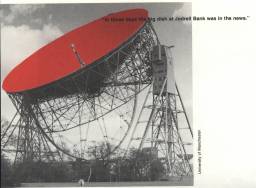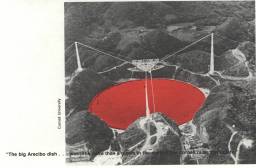|
Twenty Years After . . . .
By: Philip Morrison
A magnificent piece that links the past to the future with some very sage advice.—Eds.

"In those days the big dish at Jodrell Bank was in the news."

"The big Arecibo dish . . . was little more than a gleam in the eyes of the Cornell radio physicists."
Twenty years may be long enough to justify a few personal reminiscences. They begin during a chamber music performance in the Cornell Student Center when I first came to think about the promise of gamma-ray astronomy. The idea seemed good, and I am afraid I paid less than due attention to the quartet. By the end of 1958, I had published the first summary of what one might learn from gamma ray astronomy. Like most theorists, I badly underestimated the experimental difficulties and it was to take almost fifteen years before innovative experiments produced results. But the paper was interesting and made the challenge an inviting one.
One spring day, a few months after its publication in 1959, my ingenious friend Giuseppe Cocconi came into my office, which looked northward out over a small lake to the green hills of Ithaca. Giuseppe posed an unlikely question. Would not gamma rays, he asked, be the very medium of choice for communication between the stars? They would work, that was plain, and my answer was enthusiastic yet cautious. Shouldn't we look at all of the electromagnetic spectrum for its possibilities, and genuinely seek out the best means for such a link?
"We have passed through what I would call the pioneer stage."
In those days the big dish at Jodrell Bank was in the news, and the fiasco of Sugar Grove was in the planning stage. I do not recall whether we knew even the mere rumor of the big Arecibo dish, then perhaps little more than a gleam in the eyes of the Cornell radio physicists. Certainly neither of us knew the rudiments of radio astronomy. It took a few weeks of reading and discussion to come to understand that: "The wide radio band from, say, 1 megacycle to 104 megacycles per second, remains as the rational choice." Together we wrote and rewrote the short letter Searching for Interstellar Communications which from the first we had hoped to publish in the rather speculative pages of Nature.
Giuseppe wrote to Sir Bernard Lovell directly, urging him to devote some time for this task at Jodrell Bank, but Lovell was intensely skeptical (Sir Bernard later wrote that he regretted his indifference to our proposal).
Giuseppe and I knew, of course, that our proposal was both unorthodox and improbable, but we held, and we still hold, that its argument compels serious attention. "The probability of success is difficult to estimate; but if we never search, the chance of success is zero."
I sent the letter to Nature in London via Professor Blackett, the influential and imaginative physicist then in Imperial College, whom I knew personally, to seek his good offices in having it accepted. He acted promptly and successfully, and the note soon appeared.
"Whether we are alone or not needs to rest on experimental search, not on a string of evolutionary inferences."
By the time of its publication, I had left the United States for a year's stay abroad, a round-the-world sabbatical, and I recall the hints of public interest, as various journalists tried to reach me in far away places in Europe and Asia after the article had come out.
How does the question look after these twenty years? First of all, we have passed through what I would call the pioneer stage. Following Frank Drake's path-breaking Ozma — the first real search — a half-dozen teams of radio astronomers in the USA, in Canada, and in the USSR have devoted serious effort to the search. A few of these have even used specially-built equipment for some time, but on the whole one could characterize their searches as preliminary. None of them prepared to continue, with improvements and expansion of effort, for a protracted search, gaining capabilities commensurate with less optimistic estimates of the task. These pioneers have shown the way and our debt to their ideas and devotion is great, but the absence of positive results so far is not at all unexpected. These are people who have walked past the haystack, picked up a few handfuls of straw, and searched cleverly for a needle. This pioneer phase is not quite over; for me, its end would be marked by an effort rather like that proposed by NASA in the spring of 1978 for funding by Congress: a scheme aiming at some specially-constructed equipment, and its progressive use in a systematic way for some years, on the scale of an important radio astronomy project. The task would be shared among several big dishes, using one only for a portion of the time, rather than devoting one dish to the work exclusively. It is humanly unattractive to demand that individual people spend decades in a search which offers no success, even though the eventual outcome is of great social importance. Much better, it seems, to divide the task, so that no one finds a whole career spent in an important but so far fruitless search.
"We are finite beings, with finite capabilities, growing but limited, who are by no means sure either of becoming universal or remaining alone. Perhaps, we can find out, and that is what we ought to do."
The ubiquitous rise of computing power has been the most positive change in twenty years. People speak easily now of megachannel spectral analyzers and more; it becomes clear that we can carry out a search even if all the guessed strategies about special channels or directions or times prove wrong. What seems needed is to pass from the pioneer phase to a systematic stage, and to learn how and what to do by serious trials. The most negative change in twenty years has been the slowness of the scientific maturity of the auxiliary questions. We have as yet no clear result and have found no life anywhere else in the solar system. The early claims of dark companions of some stars, pointing to the existence of other planetary systems, now seems less than certain. In any case, those stars thought to have planets were not close analogies to our solar system. They are red dwarfs with apparently rather massive companions. Here is where I hope for the earliest real success: there are several new methods which may enable a much wider search for other "solar systems" within the decade.
For me, of course, the point has never been that we need to know much more about the chances before we search. The point is that only a search can make empirical what is after all a very old speculation. Whether we are alone or not needs to rest on experimental search, not on a string of evolutionary inferences. For I do not believe that our science is yet close to reliable theories of planet formation, of the origin of life, or especially the evolution and duration of communicative societies.
A curious view has grown up, which I may call Malthuian. It is something like the assumption of Malthus, that human society or its counterpart will sustain indefinite growth in numbers and capability, so that we will be pressed to travel and swell among the stars, filling the Galaxy in a geological epoch or less. But a simple look at the Galaxy, which shows no signs of intense colonization, strongly suggests that we here must be the first.
"Where is everybody?" is a question already more than thirty years old. Even this argument is more plausible than the opposite one, which I might attribute to Aristotle, that our planet is the single little blue footstool in all the universe, and no other place can harbor mind – and radio telescopes. But it seems to me neither position is as persuasive as the Copernican view taken in our 1959 letter, which suggests that we are finite beings, with finite capabilities, growing but limited, who are by no means sure either of becoming universal or remaining alone. Perhaps we can find out, and that is what we ought to try to do.
Finally, the task requires patience and a mixed strategy, that is, a plan which does not place every egg in one basket. We face ignorance, and we seek to lessen it. That requires a modest stance, willing to try in many directions, and to learn by doing. Even the microwave choice is not sure, though it seems still to me much the most I likely. Indeed, I find myself still of the belief that the 21 centimeter line remains the best guide; of course, not right on top of it, but in its neighborhood, implying a small band search tempered by other knowledge. For example, if ever there are to be found the heroic extragalactic signals — hard to accept because of their demands on power and patience — they are most likely to be emitted at the 21 centimeter lines viewed in the cosmic rest frame, the frame defined by the microwave thermal background. This is universally known to every observer, and even now to a part in a thousand. Of course, one should tune to different frequencies as different directions are scanned, for the sun is moving with respect to that great stationary frame. But the frequency choice is almost without ambiguity.
The many radio lines which have been found since the 21 centimeter discovery seem by the very number to lack equal promise, though they ought not to be disregarded. In the same way, narrow-band acquisition signals still seem the best choice, but other forms of modulation, far less familiar than steady signals or even simple fast pulses, deserve consideration. All of this will follow as the search effort becomes stronger and more systematic.
"We face ignorance, and we seek to lessen it. That requires a modest stance, willing to try in many directions and to learn by doing."
The problem of interference from satellites is serious and one very much hopes for recognition of the SETI task and for some measure of frequency protection to come from the World Administrative Radio Conference meeting in Geneva. Every interested person can play some part by urging, through his or her government, protection for the rest of the century, the time span addressed at Geneva.
Just today as I wrote this piece, I realized that the then new 1959 astronomy volume of Joseph Needham's magnificent work, Science and Civilization in China, had caught my imagination during the same months that Giuseppe Cocconi and I were working out the Nature letter. I do not at all recall noticing it, but it would be agreeable to think that I had read his translation from old Teng Mu (on page 221 of volume 3), ending with the now familiar words:
"How unreasonable it would be to suppose that, besides the heaven and earth which we can see, there are no other heavens and no other earths?" (From The Lute of Po Ya, 13th century A.D.)

"Perhaps the most important result of (extraterrestrial) contacts might be the simple proof that other intelligent races do exist. Knowledge that (they) had safely passed their nuclear crises would give us renewed hope for our own future. It would help dispel present nagging doubts about the survival value of intelligence. We have, as yet, no definite proof that too much brain, like too much armor, is not one of those unfortunate evolutionary accidents that leads to the annihilation of its possessors." Arthur C. Clarke in "When the Aliens Come".
|
![[NAAPO Logo]](../../Images/NAAPOsm.jpg)
![[NAAPO Logo]](../../Images/NAAPOsm.jpg)